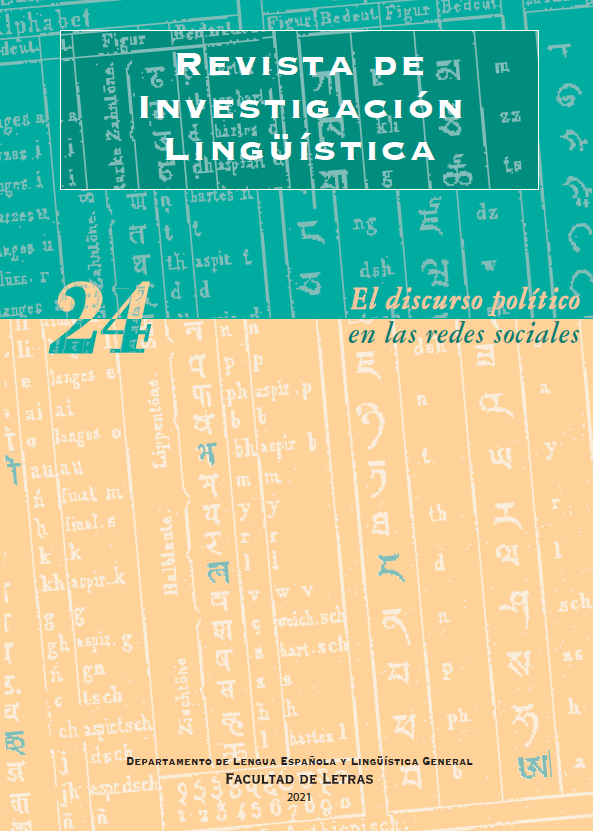Hashtags in the Spanish institutional discourse about Covid-19 on Twitter
Abstract
This paper presents the results of a pragmalinguistic analysis of the hashtags included within the tweets published in the profiles of the Spanish government, the Ministry of Health and the Public Health agency from May 2020 to May 2021. The study aims at identifying the linguistic formal and content similarities and differences of the hastags related to the Covid-19 disease, that were used within these accounts, and determining the role played by this affordance in the Spanish public institutional discourse about the pandemic. The results show that there are significant differences regarding the number of hashtags used, while, formally and functionally, they are used in a similar way in order to contextualize the message, and to inform and persuade citizens.
Downloads
-
Abstract562
-
PDF (Español (España))736
References
BANI, Sara (2020): «La comunicación institucional en las redes sociales: los cuerpos de seguridad en Twitter», Cuadenos AISPI, 16, 2, pp. 63-86.
CALLEJA, María Antonia (2020): «Contagio del ébola en España: ejemplo de cómo no comunicar una crisis», Cuadernos Artesanos de Comunicación, 178, pp. 83-99.
CAMILLERI, Mark A. (ed.) (2020): Strategic Corporate Communication in the Digital Age, Emerald, Bingley.
CARRATALÁ, Adolfo y María GALÁN (2016): «Estrategias comunicativas en Twitter de los ayuntamientos españoles gobernados por plataformas ciudadanas», Revista F@ro, 2, 4, pp.126-150.
CASERO RIPOLLÉS, Andreu (2020): «Impact of Covid-19 on the media system. Communicative and democratic consequences of news consumption during the outbreak», El profesional de la información, 29, 2, pp. 1-11.
CASTILLO ESPARCIA, Antonio, Ana Belén FERNÁNDEZ SOUTO e Iván PUENTES RIVERA (2020): «Comunicación política y Covid-19. Estrategias del Gobierno de España», El profesional de la información, 29, 4, pp.1-22.
CHADWICK, Andrew (2013): The hybrid media system: Politics and power, Oxford, Oxford University Press.
GONZÁLEZ BENGOECHEA, Aitor (2015): «Redes sociales y política: El uso comunicativo de Twitter por parte de los principales partidos políticos», Fòrum de recerca, 20, pp. 539-555.
GUTIÉRREZ-RUBÍ, Antoni y Carles PONT-SORRIBES (coords.) (2020): Comunicación política en tiempos de coronavirus, Barcelona, Cátedra Ideograma-UPF.
HEYD, Theresa y Cornelius PUSCHMANN (2017): «Hashtagging and functional shift: Adaptation and appropriation of the #», Journal of Pragmatics, 116, pp. 51-63.
IBÁÑEZ PEIRÓ, Ángel (2020): «La actividad informativa del Gobierno español durante la emergencia sanitaria provocada por el coronavirus, COVID-19», Revista Española de Comunicación en Salud, 1, pp. 304-318.
LÓPEZ EIRE, Antonio (1998): La Retórica en la publicidad, Madrid, Arco / Libros.
LÓPEZ-GARCÍA, Guillermo (2020): «Vigilar y castigar: el papel de militares, policías y guardias civiles en la comunicación de la crisis del Covid-19 en España», El profesional de la información, 29, 3, pp. 1-15.
MANCERA RUEDA, Ana y Uta HELFRICH (2014): «La crisis en 140 caracteres: el discurso propagandístico en la red social Twitter», Cultura, Lenguaje y Representación, vol. XII, pp. 59-86.
MÁS, Lluís y Frederic GUERRERO (2019): «The use of hashtags as a political branding strategy», Revista Internacional de Relaciones Públicas, vol. IX, 17, pp. 5-24.
MENNA, Laura (2012): «Nuevas formas de significación en red: el uso de las #etiquetas en el movimiento 15M», Estudios de Lingüística del Español, 34, pp. 1-61. En línea: http://elies.rediris.es/elies34/Tesina_L-Menna.pdf [22-05-2021].
MORENO, Emilio (2008): «Gestión de la información y la comunicación en emergencias, desastres y crisis sanitarias», Emergencias: Revista de la Sociedad Española de Medicina de Urgencias y Emergencias, 20 (2), pp. 117-124.
PULIDO-POLO, Marta, Víctor HERNÁNDEZ-SANTAOLALLA y Ana LOZANO-GONZÁLEZ (2021): «Uso institucional de Twitter para combatir la infodemia causada por la crisis sanitaria de la Covid-19», El profesional de la información, 30, 1, pp. 1-15.
SALAZAR, Eduardo (2017): «Hashtags 2.0 - An Annotated History of the Hashtag and a Window to its Future», Icono 14, 15 (2), pp. 16-54.
SCOTT, Kate (2015): «The pragmatics of hashtags: Inference and conversational style on Twitter», Journal of Pragmatics, 81, pp. 8-20.
SUAU-GOMILA, Guillem, Salvador PERCASTRE, Gemma PALÀ y Carles PONT-SORRIBES (2017): «Análisis de la comunicación de emergencias en Twitter. El caso del Ébola en España», en Javier Sierra y Sheila Liberal (eds.), Uso y aplicación de las redes sociales en el mundo audiovisual y publicitario, Madrid, McGrawhill, pp. 119-130.
TIRADO, Alejandra (2018): «El papel de Twitter en la estrategia de comunicación institucional en situaciones de emergencia: El caso de los atentados terroristas de Barcelona de 2017», Fòrum de Recerca, 23, pp. 31-49.
ZAPPAVIGNA, Michelle (2011): «Ambient affiliation: a linguistic perspective on Twitter», New Media Society, 13(5), pp. 788-806.
Copyright (c) 2022 Journal of Linguistic Research

This work is licensed under a Creative Commons Attribution-NonCommercial-NoDerivatives 4.0 International License.
The works published in this magazine are subject to the following terms:
1. The Publications Service of the University of Murcia (the publisher) preserves the economic rights (copyright) of the published works, and favors and allows the reuse of same under the license of use indicated in point 2.
2. The papers are published in the electronic edition of the magazine under a Creative Commons Attribution-NonCommercial-NoDerivative 3.0 Spain license (legal text). Papers may be copied, used, disseminated, transmitted and publicly exhibited if the following requirements are met: i) The authorship and the original source of its publication (magazine, editorial and URL of the work) must be cited; ii) The works cannot be used for commercial purposes; iii) The existence and specifications of this user license must be explicitly mentioned.
3. Self-archiving conditions. Authors can electronically disseminate pre-print versions (version before being evaluated) and / or post-print versions (version evaluated and accepted for publication). This makes possible its circulation and diffusion earlier and with it a possible increase in its citation and reach among the academic community. RoMEO color: green.









